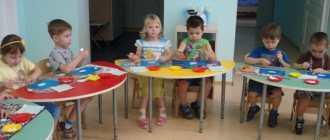The author is Elena ISAEVA, teacher at Municipal Preschool Educational Institution No. 3 “Teremok”, Omsk.
Any event with children in kindergarten is not an easy event. The main feature of holiday matinees or daily activities are games. Outdoor games in kindergarten are the most important element in the upbringing and development of a child. It is games in kindergarten that shape character and develop children’s ingenuity and intelligence. We must remember that play gives a child true joy, which penetrates deeply into the soul and remains there forever.
For each age, their own outdoor games have been developed in kindergarten, which take into account the psychological and physiological characteristics of a particular age. The organization of events involves mandatory games in kindergarten, when both fairy-tale characters and the children themselves become participants in entertaining and playful activities. After playing games in kindergarten, both children and parents will be satisfied! That is why competent organization of games in kindergarten will give every child unforgettable emotions.
Games in kindergarten, in essence and method of implementation, can be divided into several types. Each type of games in kindergarten, despite the general similarities, has its own differences.
Story games in kindergarten
STORY GAMES IN KINDERGARTEN are built on the basis of children's knowledge of the life around them. Different professions, types of transport, natural phenomena, and especially often the habits of animals and birds: the cunning of a fox, the rudeness of a wolf, the speed of a hare, as well as thunder, rain, traffic - all this forms the basis for establishing the rules of the game in kindergarten.
When playing HORSE, kids run, raising their knees high, like horses.
The game is as follows: one of the children becomes a horse (usually the most active boy is chosen). Long ribbons are tied to his shoulders. Two or three children will immediately pretend to be a cart. They pick up a ribbon and shout “But-But!!!” make the horse run in a circle. All other children stand in a circle. The driver stops near each child, and the next passenger loudly says where he wants to go: to grandma, to mom to work, to kindergarten. When the cart with a passenger sets off for the next circle, all the children try to run in unison, raising their legs high. And the horse, at the same time, can still buck. This game develops a “sense of elbow”, since the cart must move smoothly; Children should not repeat the purpose of the trip, but come up with new ones each time. If one of the passengers or drivers loses the rhythm, then the teacher can remove such a child from the game, inventing, for example, that the cart’s wheel has broken. The game ends when all the children have ridden.
Repeating the movement of the bunnies who run away from the scary gray wolf in the game HARES AND THE WOLF, children jump like bunnies and hide wherever possible.
The game develops a quick reaction in children. At the beginning, all the bunny children are jumping and frolicking at the edge of the forest. The edge of the forest is the middle of the playground in the playroom, which is furnished with chairs.. But the teacher immediately warns that somewhere nearby a scary and hungry gray wolf is wandering through the forest. And the kids must be on alert all the time. After a certain time, the teacher shouts: “Gray wolf!” All children must have time to hide behind their chairs. Whoever doesn’t make it in time is grabbed by the gray wolf and impromptu dragged into his lair - the next room. This child is automatically eliminated from the game. The game continues until all the hares have been caught.
The children's interactions are very close. When pretending to be a train, in the game STEAM LOT, children move synchronously one after another, trying not to bump into the trailer in front.
Children are a locomotive and carriages. All the kids stand behind each other, grab each other by the waist and begin to move in unison. The teacher will first place chairs that will indicate the area: stations, forest, bridge, house. The locomotive must smoothly go around all obstacles and safely reach the final station. The cars must move synchronously and slow down at the station in advance. As the train progresses, children in carriages should try not to bump into the carriage ahead. Otherwise, the teacher will announce an accident. All children in the group can take part in this game. Just like in the game HORSE, you can leave some of the trailers at passing stations. And the children must figure out why the carriages are detached from the train: carriages with mail, freight cars and other reasons. It is also good to place road signs regarding the railway. Children will immediately learn the rules of behavior on the railway tracks.
In the TRAFFIC LIGHT game, children's cars brake and stop at a red light when the "traffic light" waves a red flag. At the words of the teacher - Rain, rain - the baby birds quickly scatter to their nests.
This game simply must be played more often so that the children learn the rules of crossing streets. One of the guys is chosen to be a traffic light. They give him three circles: yellow, green, red. By raising the circles, the child represents a traffic light. The remaining children are divided into: transport, pedestrians and police officers. All participants in the game must move through the intersection according to the established rules. Boys can depict cars, and everyone must come up with a brand, color and a unique “beep”. Girls can transport strollers with dolls. A policeman stands at his post and punishes violators. Whoever breaks the rules is eliminated from the game.
Organization of outdoor games
Methodology for organizing outdoor games . How to organize an outdoor game. Functions of the teacher in organizing the game. Game selection. Selection of equipment and determination of the functions and purpose of the game.
Functions of a teacher, game leader . The most important responsibilities of a professional teacher who uses outdoor games as a means of targeted, organized physical education are: performing a set of organizational actions; conducting an outdoor game with the implementation of a complex of influences of a general developmental physical-motor and educational nature. Organizational actions of the teacher include: choice of game and factors of its effectiveness; analysis of the systemic and structural essence of the game; preparation of the game venue, equipment and auxiliary equipment. Organization of children for playing the game includes: explanation of the content of the game; placement of players with clarification of individual functions and rules; identification of drivers (if necessary); team formation; selection of captains; appointment of teaching assistants and explanation of their responsibilities, appointment of judges if necessary. Carrying out the game includes direct control of the game process, including: monitoring the progress of the game, compliance with the rules; personal implementation of refereeing; load adjustment; ending the game; summing up the game.
Choice of game and conditions for its successful implementation. The content of the selected outdoor game is determined by the goal factor and the main objectives of the lesson, or another form of classes within which it is supposed to be carried out. For a teacher, it is important that playing a game just for the sake of playing is a rather wasteful pastime based on the strategic goal of physical education - the formation of the physical culture of the child’s personality . As noted earlier, the selection of a game is based, first of all, on the main objectives of the lesson and the psychophysiological characteristics of the age of the participants in the game, the general level of their physical development and motor readiness, and the quantitative ratio of boys and girls in teams.
The organizational form of classes, or the event within which the game is supposed to be held, has a decisive influence on its preparation and conduct. The most acceptable form of academic lesson in educational and educational aspects, one of the elements of which is an outdoor game. It is in the lesson regulations that you can plan and purposefully solve the assigned tasks, since the lesson form determines age, gender, and the time allotted for the lesson.
Other forms, for example, classes in a summer camp, during a break between classes, impose additional professional responsibility on the teacher conducting the game due to the possible different ages of the participants, different initial physical fitness, time limits for the game and other associated factors.
The most suitable place for outdoor games is a summer sports ground or gym, which allows children to fully demonstrate their physical activity. Conducting games in school recreational conditions requires the conductor to demonstrate creativity, extraordinary organizational decisions, and, in general, fairly high professionalism.
The time of year and weather conditions certainly influence the choice of game and its content. In warm summer months and in hot weather, it is necessary to plan games with little physical activity to avoid overheating of the child’s body. And vice versa, in winter weather conditions, the chosen game should be full of active movements and movements.
Changes can be made to the content of the selected game in accordance with the organizational situations that arise (large or too small number of participants, lack of equipment, etc.). Changes in the game and rules as proposed by them are quite emotional and positively perceived by children, especially if this leads to better organization of the game and the quality of its implementation.
The analysis of the consistency and structure of the game is carried out by the teacher in the process of personal preparation for its implementation. Creating an idea of the game as a system allows you to highlight its main elements, their functions during the game, and think through the features of direct and indirect connections between the elements. The process of the game is something other than the implementation of connections between its components, for example, the interaction of the teacher and the team, the captain and the team, the implementation of the functions of assistants and the participation of the teacher in this, the influence of referees on the management of the game.
In the process of preparing for the game, the teacher must present the game in a structural aspect, that is, determine for himself the place, role and significance of each of the components of the game as a system. The game director must imagine all possible situations caused by the course of the game and think through possible solutions. It is important to foresee possible negative manifestations and imagine ways to eliminate them. In the system of outdoor play, the main elements are the players and the teacher-leader. Each participant in the game is an individual who has a different attitude towards the game and expresses himself in it. The teacher’s task is to create conditions under which all players, including passive and poorly prepared ones, would ultimately actively participate in it.
A preliminary analysis of the game involves the teacher choosing and assigning assistants, endowing them with functions corresponding to the content and conditions of the game. At the same time, assistants should, if possible, familiarize themselves with the game and its rules in detail.
Preliminary preparation of the venue for the game is an indispensable condition for its success. It is important to know that the participants in the game subtly sense the presence of preliminary preparation, which is manifested in their positive emotions, desire to play, and otherwise in indifference to the upcoming game.
Examples of preparing the venue for the game include appropriate marking of the site using various kinds of landmarks; drawing boundary lines, placement of equipment and aids in connection with the content of the game; clearing the site of snow, eliminating rain puddles, etc.
When preparing the venue for the game, you should remove all foreign objects that interfere with the progress of the game. When playing with the ball indoors, it is necessary to take into account its possible impacts on the glass, and with this both injuries and material waste. Windows must be protected with elastic or rigid mesh. If the conditions of the game are quite simple, then it is advisable to carry out the preparatory actions together with the participants of the game, which increases their organizational and emotional mood for the game actions.
Preparation of equipment and auxiliary equipment can be carried out by the teacher himself and his assistants. But the created situation in which all players actively participate in the preparation is especially valuable. The most popular equipment in outdoor games are balls, gymnastic sticks and jump ropes, hoops, and skittles. Colored vests and armbands are used to distinguish players and teams. Gymnastic apparatus, especially in relay races, and wooden cubes can be used as auxiliary equipment.
Inventory and auxiliary equipment are selected, and if necessary, specially created by student activists in accordance with the content and conditions of the game. The weight and size of equipment must correspond to the physical capabilities of the players. Storage of equipment, as a rule, is carried out in a specially designated place. But before the game, it is advisable to place it in places convenient for their quick placement in accordance with the game conditions.
It is advisable to explain the essence of the game in the formation or role arrangement of the students with which the game begins. The success of explaining and perceiving the essence and conditions of the game depends on how clearly, accurately and professionally the teacher himself imagines it. The explanation should be consistent, logical, and brief, except in the case of games of preschoolers and primary schoolchildren. At this age, a detailed, unhurried explanation is required due to the specifics of the perception of information by children of this age.
In the theory, methodology and practice of outdoor games, a fairly simple and reliable scheme for explaining the essence of the game has developed and operates. It consists of: the name of the game, its main distinguishing feature; game content; the roles of the players and their location on the court; assistant functions; rules of the game; conditions for determining the winners; answers to questions from game participants, which are addressed to all children. Particular attention should be paid to the rules of the game so as not to make forced stops during the game to clarify them. The explanation should be clear, with clear diction, with moderate emotions, but not monotonously, in a language accessible to children. In rare cases, to sharpen attention to the content of the game, rules and conditions, the teacher can use the technique of a short selective survey of listeners.
It is advisable to use every opportunity to simultaneously tell and show motor fragments of the game. An explanation of the essence of the game and the rules should be carried out when maximum attention of students to the actions of the teacher is achieved. The explanation of the content of the game and the conditions must be consistent, logical, and harmonious. In this case, it is advisable to be guided by the following story plan: the name of the game; the role of the players and their location; sequence of game actions; rules and other conditions of the game. When explaining the game, one should take into account the general mood of the children and the general psychological background of the team. If children's attention decreases during the story, it is necessary to shorten the explanation, if possible without compromising its meaning and the emotional side of the upcoming game. The explanation ends with answers to students’ questions, if any, and the answer should be addressed to all players. In cases where the game is repeated, attention is usually paid to its key points and clarification of the rules. An effective pedagogical technique is a selective survey of students about the meaning and content of the game, about the peculiarities of the rules for its implementation.
Placement of players with the definition of individual functions and rules of the game . An explanation of the essence of the game can be carried out in an organized formation of children, less often with their random but grouped placement. The most rational way of explanation is a story carried out in the position of the players in which the game begins. With different options for placing players, it is important that the teacher sees all the children, and they, in turn, see the teacher.
If the game begins with children moving in all directions, then to explain the game and starting actions, children are placed in a line or grouped near the teacher, but with the condition of a good mutual overview. When playing in a circle, the teacher takes a place to explain in the row of players, which ensures a good overview for everyone and the same perception of the story. The teacher should not be located in the center of the circle or even at some distance from it, since for a large number of players the meaning of the explanation of the essence of the game and the rules may not be heard. If the game is of a team nature, and the starting arrangement involves a line or column, then the teacher must, for the purpose of explanation, bring the team members closer together, position himself in the middle between the players, and be sure to turn them to face him. When explaining, the teacher should, without unnecessary emphasis, alternately address the players of one and the other team.
When starting placement, it is important to take into account the direction of the sun's rays and anticipate their effect on the listeners. Otherwise, the children's attention will be scattered by the rays of the sun. The same applies to the teacher when he is positioned in front of the students.
When placing children for a game, it is important to calculate the teacher’s position to show the elements of the game at the same time as the story. It is important that when demonstrating the teacher's actions, they are obvious to everyone playing.
Determining the individual functions of the players may include: dividing children into teams; choice of drivers; appointment of assistants.
Creating a team of players can be done in a number of ways. If it is necessary to create teams of equal strength, then this will be organized by the teacher himself as the most oriented in the preparedness of children. This method is acceptable in cases where outdoor games that are quite complex in content are played, as a rule, with elements of sports games, which corresponds to the age of high school.
There is a gymnastic method of distribution into teams by calculation. In this case, the children first line up in a “boys-girls” formation, and by a given calculation “first-second”, or “first-second-third”, etc. Each player receives his team number. This method allows you to quickly, most often in a physical education lesson, prepare for the game.
Distribution into teams can also occur through the use of figure marching techniques, for example, crushing. But this method, like any other, is applicable provided that the students master the elements of figure marching and the total number of players is an even number with an equal number of girls and boys.
For distribution into teams, it is possible to use the organizational method “by agreement”. It consists in the fact that children choose captains in pairs in which they were previously united and preferably based on approximately equal readiness. At the same time, children in pairs agree on which captain’s team they will play on. The captain, by calling a player, assigns him to his team. This method is emotional, takes into account the child’s individuality, has the character of a game even before the game and is quite popular among children and organizers.
There is a way to create teams "by captain's choice". The captains chosen by the players take turns selecting children for their team. This method is characterized by the speed of creating fairly equivalent teams. However, captains must be prepared for the fact that among the children there are also poorly prepared ones, so as not to leave them without attention, or better yet, to specifically invite such a child to the team, thereby placing trust in him and giving him the opportunity to fully express himself in collective actions. In the implementation of this method, the role of the teacher in preparing children for the role of captain is undoubted. This method is also most acceptable for high school students, who are already able not only to identify supporters by their level of preparedness, but also to perform personal actions, showing attention to insufficiently prepared children.
The selection of drivers and captains is an action that is quite subtle from a psychological and pedagogical point of view. Since there is an authoritarian method, when the driver is appointed by a teacher or game director, as well as a collective method - by the players themselves, there are a number of features that are important to consider when organizing the game. So, if captains are appointed only by the teacher, and often by the same students, then there is a danger of such children being singled out as close ones, loved by the teacher, which is, of course, unacceptable. On the other hand, it is also unacceptable for children to constantly choose the most prepared captain, since in this way conditions are not created for the manifestation of leadership qualities in less prepared children. Therefore, the teacher must have in his arsenal a number of ways to select captains, leaders, taking into account the psychological characteristics of children of a certain age and the possibility of demonstrating and developing leadership qualities.
The teacher himself can appoint a captain or driver. This method has one advantage - the quick organization of the game, but the will of the group of children is not taken into account. This shortcoming can be mitigated when the teacher explains the motives for his decision, and thus the negative of the volitional (non-game) decision will be weakened.
A common way to select a game leader is by lot. Selection by lot can be carried out by calculation, urgent solving of a riddle, a quick quiz, and in the simplest way - throwing a coin. Team compositions can be determined in the same way. As a draw, you can use a gymnastics stick, which the competitors grab from bottom to top with a hand, with the winner being determined by a complete, whole hand, grip from above.
An emotional way to determine the captain or driver is by drawing lots, based on drawing out straws held in the teacher's hand. The one who draws the shortest straw becomes the leader of the game.
When organizing the game, a method is used to select the driver according to the best, long-range throwing of the available projectile. Along with certain advantages, this method may not allow a poorly prepared child to feel like a leader.
There is a way to appoint the winner of the previous game as the driver. This approach stimulates children’s play activity, but even in this case, moderately and poorly prepared children may remain outside the zone of leadership attention.
The fairest way to assign a choice of captains or drivers is to establish the order in which such functions are performed. In order to avoid self-refusal, the teacher should explain the functions of the driver or captain, the significance of this role in determining the life position of each student, in the formation of organizational and management skills.
The assignment of assistants is carried out by the teacher to monitor compliance with the rules of the game, determine its result, and place equipment determined by the content of the game. The role of the assistant is also important for the formation of his social activity. Therefore, it is very advisable for all the players to play the role of assistants, and perhaps more often during the school year.
The teacher announces to the game participants the assigned assistants without explaining the reasons for his choice. Assistants can be appointed on their own initiative, at the request of the child. The number of assistants depends on the content of the game, the conditions of its implementation and the complexity of the rules. Assistants are appointed, as a rule, after an explanation of the essence of the game and the selection of captains or drivers. Children with weakened physical development or those exempted by a doctor from physical activity can be assigned to the role of assistants. If an outdoor game is played in an open area, on the ground, then assistants should be appointed in advance in order to carry out good preparation for the game in difficult conditions.
Similar articles:
Use of outdoor games for children aged 16 to 17 years
Classification of modern outdoor games
The essence of outdoor games
On the role of outdoor play in child development
Use of outdoor games for children from 11 to 15 years old





